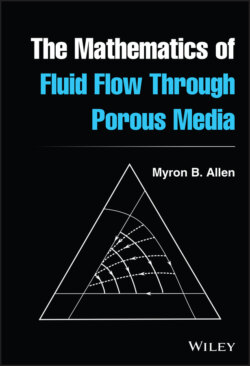Читать книгу The Mathematics of Fluid Flow Through Porous Media - Myron B. Allen III - Страница 27
2.4.1 Hagen–Poiseuille Flow
ОглавлениеOne of the earliest known exact solutions to the Navier–Stokes equation arose from a simple but important model examined by Gotthilf Hagen, a German fluid mechanician, and French physicist J.L.M. Poiseuille, mentioned in Section 2.3. Citing Hagen's 1839 work [67], in 1840, Poiseuille [122] developed a classic solution for flow through a pipe. The derivation presented here follows that given by British mathematician G.K. Batchelor [16, Section 4.2].
Consider steady flow in a thin, horizontal, cylindrical tube having circular cross‐section and radius . Let the fluid's density and viscosity be constant. Orient the Cartesian coordinate system so that the ‐axis coincides with the axis of the tube.
The problem simplifies if we temporarily convert to cylindrical coordinates, defined by the coordinate transformation
(B.5)
reviewed in Appendix B. Here represents position along the axis of the tube, represents distance from the axis, and the angle represents the azimuth about the axis. In this coordinate system, the Laplace operator has the form
(B.7)
Appendix B reviews the derivation of this expression.
In view of the symmetry of the problem about the axis of the tube, we seek solutions of the form
(2.17)
that is, the axial component depends only on distance from the axis of the tube, and the radial and azimuthal coordinates of the velocity vanish, as drawn in Figure 2.10. We allow the pressure to vary with .
Exercise 2.10 Show that, under these conditions, the nonlinear term vanishes. Work in Cartesian coordinates.
Figure 2.10 Profile of flow through a thin circular cylinder having radius .
Since the flow is steady, the Navier–Stokes equation therefore reduces to
(Here we use the dimensionless form.)
For a fluid velocity of the form (2.17), we need to only solve the first coordinate equation,
(2.18)
Since the second term on the right side of Eq. (2.18) is independent of by Eq. (2.17), so is the pressure gradient . It follows that is constant, and hence varies linearly along the tube. Equation (2.18) therefore reduces to the following ordinary differential equation:
Exercise 2.11 Verify that the general solution to this equation has the form
where stands for the natural logarithm and and denote arbitrary constants.
For boundary conditions, we assume no slip at the wall of the tube and insist that the velocity along the axis of the tube remain finite:
(2.19) (2.20)
The condition (2.20) requires that .
Exercise 2.12 Impose the no‐slip boundary condition (2.19) to show that
(2.21)
Equation (2.21) indicates that the fluid velocity has a parabolic profile, with the velocity reaching its maximum magnitude along the axis of the tube and vanishing at the walls. We encounter this profile again in Section 5.1.2, in discussing why solutes spread as they move through the microscopic channels of a porous medium.
